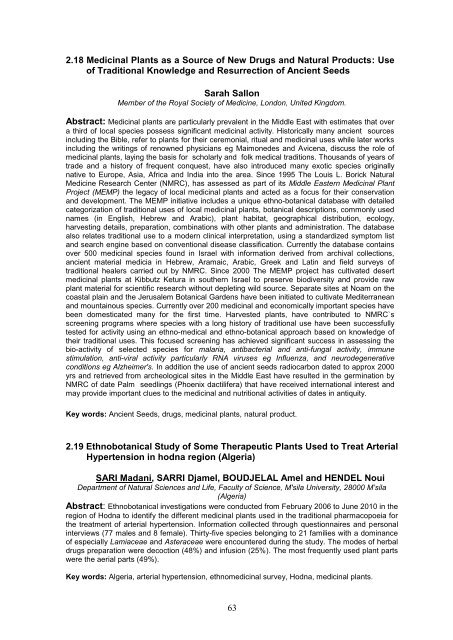Abstract Book - 3rd International Symposium on Medicinal Plants ...
Abstract Book - 3rd International Symposium on Medicinal Plants ...
Abstract Book - 3rd International Symposium on Medicinal Plants ...
You also want an ePaper? Increase the reach of your titles
YUMPU automatically turns print PDFs into web optimized ePapers that Google loves.
2.18 <strong>Medicinal</strong> <strong>Plants</strong> as a Source of New Drugs and Natural Products: Use<br />
of Traditi<strong>on</strong>al Knowledge and Resurrecti<strong>on</strong> of Ancient Seeds<br />
Sarah Sall<strong>on</strong><br />
Member of the Royal Society of Medicine, L<strong>on</strong>d<strong>on</strong>, United Kingdom.<br />
<str<strong>on</strong>g>Abstract</str<strong>on</strong>g>: <strong>Medicinal</strong> plants are particularly prevalent in the Middle East with estimates that over<br />
a third of local species possess significant medicinal activity. Historically many ancient sources<br />
including the Bible, refer to plants for their cerem<strong>on</strong>ial, ritual and medicinal uses while later works<br />
including the writings of renowned physicians eg Maim<strong>on</strong>edes and Avicena, discuss the role of<br />
medicinal plants, laying the basis for scholarly and folk medical traditi<strong>on</strong>s. Thousands of years of<br />
trade and a history of frequent c<strong>on</strong>quest, have also introduced many exotic species originally<br />
native to Europe, Asia, Africa and India into the area. Since 1995 The Louis L. Borick Natural<br />
Medicine Research Center (NMRC), has assessed as part of its Middle Eastern <strong>Medicinal</strong> Plant<br />
Project (MEMP) the legacy of local medicinal plants and acted as a focus for their c<strong>on</strong>servati<strong>on</strong><br />
and development. The MEMP initiative includes a unique ethno-botanical database with detailed<br />
categorizati<strong>on</strong> of traditi<strong>on</strong>al uses of local medicinal plants, botanical descripti<strong>on</strong>s, comm<strong>on</strong>ly used<br />
names (in English, Hebrew and Arabic), plant habitat, geographical distributi<strong>on</strong>, ecology,<br />
harvesting details, preparati<strong>on</strong>, combinati<strong>on</strong>s with other plants and administrati<strong>on</strong>. The database<br />
also relates traditi<strong>on</strong>al use to a modern clinical interpretati<strong>on</strong>, using a standardized symptom list<br />
and search engine based <strong>on</strong> c<strong>on</strong>venti<strong>on</strong>al disease classificati<strong>on</strong>. Currently the database c<strong>on</strong>tains<br />
over 500 medicinal species found in Israel with informati<strong>on</strong> derived from archival collecti<strong>on</strong>s,<br />
ancient material medicia in Hebrew, Aramaic, Arabic, Greek and Latin and field surveys of<br />
traditi<strong>on</strong>al healers carried out by NMRC. Since 2000 The MEMP project has cultivated desert<br />
medicinal plants at Kibbutz Ketura in southern Israel to preserve biodiversity and provide raw<br />
plant material for scientific research without depleting wild source. Separate sites at Noam <strong>on</strong> the<br />
coastal plain and the Jerusalem Botanical Gardens have been initiated to cultivate Mediterranean<br />
and mountainous species. Currently over 200 medicinal and ec<strong>on</strong>omically important species have<br />
been domesticated many for the first time. Harvested plants, have c<strong>on</strong>tributed to NMRC`s<br />
screening programs where species with a l<strong>on</strong>g history of traditi<strong>on</strong>al use have been successfully<br />
tested for activity using an ethno-medical and ethno-botanical approach based <strong>on</strong> knowledge of<br />
their traditi<strong>on</strong>al uses. This focused screening has achieved significant success in assessing the<br />
bio-activity of selected species for malaria, antibacterial and anti-fungal activity, immune<br />
stimulati<strong>on</strong>, anti-viral activity particularly RNA viruses eg Influenza, and neurodegenerative<br />
c<strong>on</strong>diti<strong>on</strong>s eg Alzheimer's. In additi<strong>on</strong> the use of ancient seeds radiocarb<strong>on</strong> dated to approx 2000<br />
yrs and retrieved from archeological sites in the Middle East have resulted in the germinati<strong>on</strong> by<br />
NMRC of date Palm seedlings (Phoenix dactilifera) that have received internati<strong>on</strong>al interest and<br />
may provide important clues to the medicinal and nutriti<strong>on</strong>al activities of dates in antiquity.<br />
Key words: Ancient Seeds, drugs, medicinal plants, natural product.<br />
2.19 Ethnobotanical Study of Some Therapeutic <strong>Plants</strong> Used to Treat Arterial<br />
Hypertensi<strong>on</strong> in hodna regi<strong>on</strong> (Algeria)<br />
SARI Madani, SARRI Djamel, BOUDJELAL Amel and HENDEL Noui<br />
Department of Natural Sciences and Life, Faculty of Science, M'sila University, 28000 M’sila<br />
(Algeria)<br />
<str<strong>on</strong>g>Abstract</str<strong>on</strong>g>: Ethnobotanical investigati<strong>on</strong>s were c<strong>on</strong>ducted from February 2006 to June 2010 in the<br />
regi<strong>on</strong> of Hodna to identify the different medicinal plants used in the traditi<strong>on</strong>al pharmacopoeia for<br />
the treatment of arterial hypertensi<strong>on</strong>. Informati<strong>on</strong> collected through questi<strong>on</strong>naires and pers<strong>on</strong>al<br />
interviews (77 males and 8 female). Thirty-five species bel<strong>on</strong>ging to 21 families with a dominance<br />
of especially Lamiaceae and Asteraceae were encountered during the study. The modes of herbal<br />
drugs preparati<strong>on</strong> were decocti<strong>on</strong> (48%) and infusi<strong>on</strong> (25%). The most frequently used plant parts<br />
were the aerial parts (49%).<br />
Key words: Algeria, arterial hypertensi<strong>on</strong>, ethnomedicinal survey, Hodna, medicinal plants.<br />
63

















